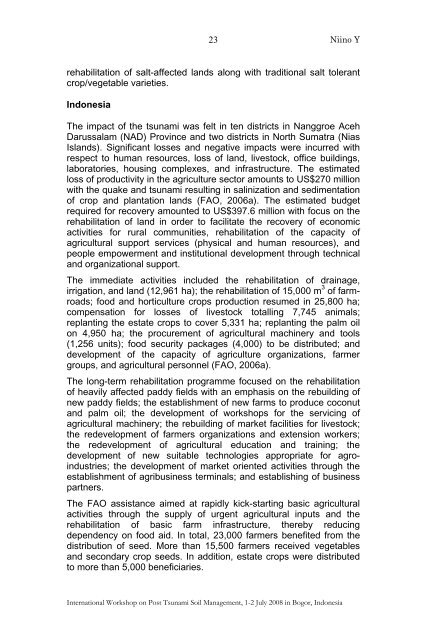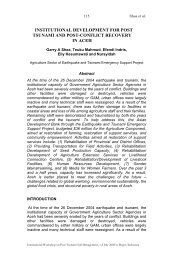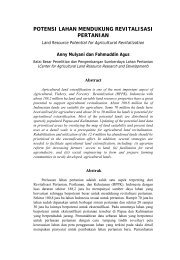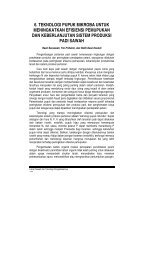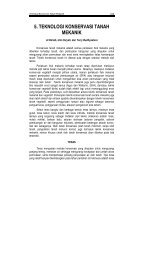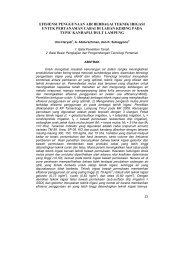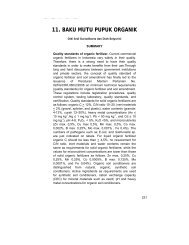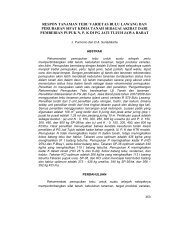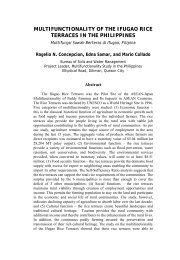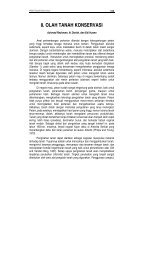Proceedings - Balai Penelitian Tanah
Proceedings - Balai Penelitian Tanah
Proceedings - Balai Penelitian Tanah
Create successful ePaper yourself
Turn your PDF publications into a flip-book with our unique Google optimized e-Paper software.
23<br />
Niino Y<br />
rehabilitation of salt-affected lands along with traditional salt tolerant<br />
crop/vegetable varieties.<br />
Indonesia<br />
The impact of the tsunami was felt in ten districts in Nanggroe Aceh<br />
Darussalam (NAD) Province and two districts in North Sumatra (Nias<br />
Islands). Significant losses and negative impacts were incurred with<br />
respect to human resources, loss of land, livestock, office buildings,<br />
laboratories, housing complexes, and infrastructure. The estimated<br />
loss of productivity in the agriculture sector amounts to US$270 million<br />
with the quake and tsunami resulting in salinization and sedimentation<br />
of crop and plantation lands (FAO, 2006a). The estimated budget<br />
required for recovery amounted to US$397.6 million with focus on the<br />
rehabilitation of land in order to facilitate the recovery of economic<br />
activities for rural communities, rehabilitation of the capacity of<br />
agricultural support services (physical and human resources), and<br />
people empowerment and institutional development through technical<br />
and organizational support.<br />
The immediate activities included the rehabilitation of drainage,<br />
irrigation, and land (12,961 ha); the rehabilitation of 15,000 m 3 of farmroads;<br />
food and horticulture crops production resumed in 25,800 ha;<br />
compensation for losses of livestock totalling 7,745 animals;<br />
replanting the estate crops to cover 5,331 ha; replanting the palm oil<br />
on 4,950 ha; the procurement of agricultural machinery and tools<br />
(1,256 units); food security packages (4,000) to be distributed; and<br />
development of the capacity of agriculture organizations, farmer<br />
groups, and agricultural personnel (FAO, 2006a).<br />
The long-term rehabilitation programme focused on the rehabilitation<br />
of heavily affected paddy fields with an emphasis on the rebuilding of<br />
new paddy fields; the establishment of new farms to produce coconut<br />
and palm oil; the development of workshops for the servicing of<br />
agricultural machinery; the rebuilding of market facilities for livestock;<br />
the redevelopment of farmers organizations and extension workers;<br />
the redevelopment of agricultural education and training; the<br />
development of new suitable technologies appropriate for agroindustries;<br />
the development of market oriented activities through the<br />
establishment of agribusiness terminals; and establishing of business<br />
partners.<br />
The FAO assistance aimed at rapidly kick-starting basic agricultural<br />
activities through the supply of urgent agricultural inputs and the<br />
rehabilitation of basic farm infrastructure, thereby reducing<br />
dependency on food aid. In total, 23,000 farmers benefited from the<br />
distribution of seed. More than 15,500 farmers received vegetables<br />
and secondary crop seeds. In addition, estate crops were distributed<br />
to more than 5,000 beneficiaries.<br />
International Workshop on Post Tsunami Soil Management, 1-2 July 2008 in Bogor, Indonesia


